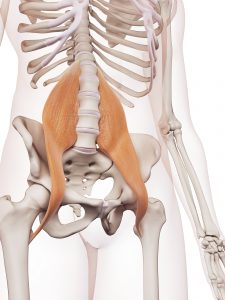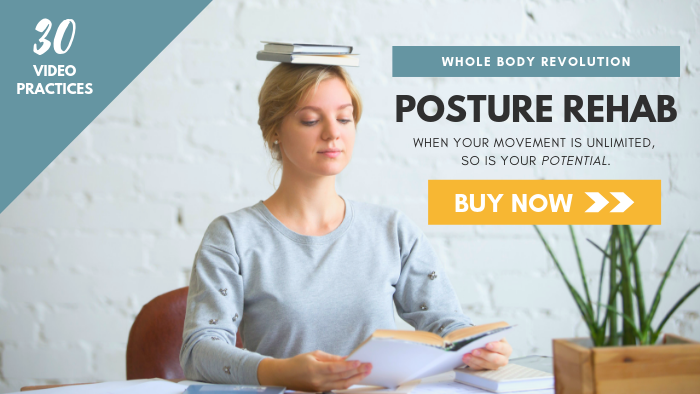As a toddler learning to walk, my brother held one arm overhead, clasped in the hand of my mother or my father. Like training wheels, holding the hand of an adult provided additional stability while he learned his own balance and coordination.
But later, long after he could walk on his own, my brother continued to hold that arm overhead because that was how he did it when he was learning. The “training wheels” of an adult had shaped his movement until his body believed that walking meant holding an arm up.
This is probably not a unique story. We all learn adaptive movement patterns as children, but later abandon them because they’re no longer useful.
I’m happy to report at as a forty-something adult, my brother no longer walks with his arm held up overhead. Can you imagine a grown person walking around the city holding one hand in the air like a toddler waiting for an adult to grab hold? Silliness.
While this movement pattern is pretty obviously not useful over the long term, we all learn more subtle maladaptive patterns throughout our lives and then hang onto them out of habit. We don’t notice the friction they put on our bodies because the low-grade discomfort fades over time into background noise.
Standing is often thought of as a box you check when you’re a toddler. Yes, she’s standing. Now she’s walking. Done and done. You don’t need to relearn or revisit those skills.
But my brother’s story illustrates the fact that just because you stand doesn’t mean you stand optimally. Just because that toddler was walking doesn’t mean he could walk for the rest of his life with his arm in the air.
And just like that toddler, you may have adopted some patterns that aren’t really serving your healthy posture and movement.
The ways in which we stand and move are patterned in many layers. Humans imitate the people around us1—and this is an efficient way to learn. But just because it shortcuts the learning curve doesn’t mean that we all learn to move in optimal ways. Everyone has a history of accidents, injuries and habitual patterns that influence their posture and movement, and when we imitate those around us, we also take on their history.
So, let’s take a look at what neutral alignment looks like in standing, and you can check yourself against the metrics to see how you stack up—pun intended.
What Not to Do

Before we dive into healthy alignment, let’s knock a few common misconceptions out of your head. I’m sure you realize by now that what you call “posture” is a multi-faceted expression combining both stance and movement, but it’s still important to make sure we’re on the same page before we delve into what constitutes healthy alignment.
Brace
Optimal alignment should feel easy. You don’t have to “set” your body in place and then nanny it with your attention to keep it there. Neutral alignment is a point of equilibrium in which you have the least amount of physical tension possible, not the most.
You don’t have to grip, force, or control your body, and being in neutral alignment is often accompanied by a feeling of lightness as your tension melts away. Neutral alignment is about letting go of as much tension as possible and still remaining upright.
Tense Shoulders
People: you really don’t have to hold your shoulders in place. Need I say it again? While generally bracing and tensing your body are practices that run counter to neutral alignment, I just have to call out shoulder tension in particular.
Shoulders that are back and down are a typical metric used to measure good posture. A whole pile of things could be structurally imperfect in a person’s body, but if their shoulders are back, they’re standing up straight by conventional standards.
And yet, your shoulders shouldn’t be tense. By pulling them back, setting them “in place” and holding them there despite their desire to roll forward, you’re inhibiting their true function, which is movement.
The shoulder joint is designed for mobility. In fact, your entire shoulder girdle, which is made up of your scapula, clavicle, and humerus, or upper arm bone, only has one single bony connection to the rest of your body, and that’s where your collar bone joins your sternum.
The rest of your shoulder bones just sort of hang in this hammock of muscle tissue. The shoulder joint itself, where your arm bone meets your scapula, is a very shallow ball and socket. In short, your shoulder is meant for movement.
When you pull those shoulders back and tighten them up, you’re bridling them and preventing mobility. Additionally, because shoulders rest on the rib cage, it’s rarely the actual shoulder that’s to blame for that dreaded forward roll.
In fact, pelvic misalignments and a sunken chest have much more impact on shoulder alignment than anything actually in your shoulder girdle. So please, do your poor exhausted shoulders a favor and release your death grip on their position.
Tuck Pelvis
At some point in their lives, nearly every single one of my clients has been told by a very well-meaning yoga teacher or Pilates instructor or other fitness-based coach that their pelvis is tipped forward and needs to be corrected.
Sometimes the correction is even more general, merely addressed to a room full of students—some vague instruction to tuck the tailbone and engage abdominals.
I get the good intention behind this cue. A lot of people in our culture have hip problems — overly tight quad and hip flexor muscles that pull their pelvis into an anterior rotation. This results in a “swayback” appearance to the lumbar spine.
While this may be true, tucking your tail and holding it there is not a beneficial correction even if a person does exhibit this pattern. But it’s especially not beneficial if you don’t even have an anteriorly tipped pelvis to begin with. Many people have a posterior pelvis — with an overly straight lumbar spine — as their postural baseline. Telling these folks to tuck their tails is extremely counterproductive as they’re already too far in this direction.
But even if you aren’t one of those posterior pelvis people, tucking your pelvis under and holding it there falls under the category of bracing. It requires muscular effort and mental control to sustain. Not only that, but those tight muscles used to hold that wayward pelvis in place now can’t perform their biological function—movement.
It’s far more useful to release the tight muscles that restrict that pelvis in the first place.
It’s also worth mentioning that what we consider as proper pelvic alignment based on anatomical charts might not actually be ideal for a living, breathing, moving body. Anatomy drawings are done from cadavers—that means dead people—lying on metal slabs. The funny thing about a body that has no animating force being placed horizontally on a solid surface is that it will tend to flatten out due to the forces of gravity.
Christine Kent, RN, author of Saving the Whole Woman: Natural Alternatives to Surgery for Pelvic Organ Prolapse and Urinary Incontinence, says that women have three wedge-shaped vertebrae in their lumbar spines, while men have two2. These “wedged” vertebrae comprise the curvature of your lumbar spine. The more wedge-shaped your vertebrae are, the more your pelvis will have a slight anterior tilt, which Kent says is actually the anatomically correct position.
So stop tucking your tail, y’all.
Clench Abs
Along with tucking your tail, clenching your abs does nothing to encourage proper alignment, despite the preponderance of oft-repeated internet advice to “brace your abs.”
In fact, your core muscles are involved in the transfer of movement from the lower extremity to the upper — not to mention their importance in breathing. Abdominals and deep core muscles like your psoas allow the impact of your foot hitting the ground to travel through your body, up your spine, and out the top of your head.
If you clench your abdominal muscles in an effort to shore up your spine or correct an imbalanced pelvis, you’re blocking that flow of movement and creating a barrier against which the impact will crash, like an ocean wave.
Often, I hear from clients that they were “fine” all their lives until one day they weren’t. They can’t pinpoint what happened, and usually they shrug it off as getting older. These subtle but insidious patterns of tension are often to blame for joint degradation over time because they eliminate the literal spring from your step and the resulting force of thousands of steps over years of life causes abrasion to soft tissue and joints.
Core Strength vs. Core Integrity
I’m starting to believe that core strength training is a religion. So many of my clients seem convinced that rock-hard abdominals are the answer to all their postural ills.
Core strength will fix everything! It will cure your back pain and allow you to lift ten million pounds! Okay, so it’s not that dramatic. But whenever I notice clients with vastly different structures all claiming the exact same prescription to fix their postural ills, I become extremely skeptical.
These core strength devotees are the people who exhibit the least amount of movement through their center, as though their midsection had been cryogenically frozen in place, allowing no sympathetic contraction of the rectus abdominis, obliques, or psoas muscle.
Please don’t misunderstand me. Core strength is an important element to a healthy structure. It’s just that my definition of core strength and the fitness industry’s probably aren’t on the same page, or even in the same book for that matter.
That’s why I prefer to use the term core integrity. Why? Because words matter. A lot.
When you mention core strength to someone, they immediately clench their abs. Remember how we talked about bracing not being useful to neutral alignment? Well, that’s bracing.
If your abs are so clenched that they can’t move, they also can’t absorb shock, and your body takes a lot of shock. Every time your foot hits the ground, a shockwave goes through your entire body.
Bracing, whether in your abs, your shoulders, quads, wherever, creates rigidity over time. Rigidity equals brittleness, and brittle structures break down. We don’t want you to be brittle. We want you to be resilient, to spring back. This is how you keep your tissues healthy and functional for life—not by bracing, but by relaxing.
Christine Kent writes that a focus on toning the abdominal wall is a relatively new practice in modern fitness, first developing prominence around the 1930s. She theorizes that this type of exercise has detrimental effects on internal organs in both women and men2.
Over-exercised abdominals put a burden on your psoas, a deep core muscle that runs from your spine across the front of your hip, attaching high up on the inside of your femur (thigh bone).

Your enteric nervous system, or “gut brain,” runs through your psoas muscle. Rigidity in this delicate core muscle can impinge these nerves which slows digestion and triggers a stress response in your body. All of this ultimately results in yet more tension—exactly what we’re trying to avoid.
What to Do

It’s really easy to tell you not to do everything you’ve ever been taught equates to good posture. But if I take all that away, then what’s left for you to do to encourage this evasive neutral alignment of which I speak?
Fear not, for I shall tell you. The following principles will help you to stand taller with more ease. And the side benefit is loose, limber movement. How can you beat that?
Stack Your Blocks
In the work that I do, we’re trained to use many different models for “seeing” the body, for assessing and understanding how different aspects of your structure relate to one another and work together. With regard to alignment, the most prevalent model is to look at the body as a series of “blocks,” or segments that stack on top of each other.
You can look at your body in this way from the front and back, or from the side. “Blocks” can shift sideways—a hip jutted out to the left, a rib cage shifted right—or forward and backward.
The more misaligned your “blocks” become, the more drag there is on your body from gravity3. When gravity runs through a well-stacked body, it gives you the sense of an elongating force lifting your chest and shoulders rather than a compressive one which drags you down. Many of my clients report a feeling of lightness after working with me and restoring this “stacked” alignment; that’s due to the release of excess muscular tension. You’re no longer pulling against gravity to hold yourself up, and therefore less effort is required.
Stacking your blocks must be done progressively from the ground up, however, if you wish to reap its benefits on your posture. Often when people work to pull their rounded shoulders back, the reason this position isn’t sustainable is because the lower “blocks” of the body are still misaligned and therefore there’s no support for your shoulders from below.
Practice

Use the following practice to give your body an experience of neutral alignment. You’ll notice that cues given are tend to be less “do this” or “stand this way” and more “feel this, explore your experience of that.”
You might love this approach, or find it frustrating and annoying. Whatever your personal preference, please know that there’s a solid reason I approach posture and movement in this way.
Telling you to “do” something doesn’t give your body the opportunity to dissolve a less efficient pattern in favor of something more useful. It overlays a new neural pattern of mental control, and thus excess tension, over the top of your old one, kind of like throwing a sheet over a pile of junk in the corner of the room and pretending it’s not there anymore.
You could also think of it in terms of software. Your body is running one program, but it has a few bugs. We could open up a new program, and run that one alongside the original, but it would bog down your computer’s memory and slow processing speed. It’s better to close out of the first program before opening a second.
Cueing you to experience your body rather than override it provides sensory data to your brain which closes out those buggy programs and creates a clean operating system for new ones to arise.
Finding Neutral Alignment
1. Stand comfortably with bare feet on a firm surface. Place your feet under your hip joints, not narrower or wider. To locate your hip joints, place your fist next to your pubic bone or groin. Your hip joint will be roughly below your pinky finger (often narrower than you would suspect).
2. Imagine your feet extending downward into the ground. You can visualize growing roots deep into the earth or your feet slowly melting into warm wax. As you do this, notice how sinking into your feet creates a sense of upward lift through your legs, hips, maybe even your spine.
3. Allow your pelvis to shift so that it’s balanced over the arches of your feet, moving it forward and backward until you find the center. Gently think of opening the front crease of your hip joint like a door hinge swinging to its widest setting. This creates space for the pelvis to move over your feet.
Notice how your spine elongates when your feet and pelvis support it fully from below.
4. To bring your shoulders over your pelvis, place one hand on your sternum and the other about two inches below your belly button. Float your sternum up and forward until the hand on your sternum is slightly in front of the hand on your abdomen. Relax your arms and shoulders, letting them hang naturally.
5. Finally, let the back of your head drift backward until your ear is over your shoulder. Resist the urge to tip your chin up or tuck it; instead, think of the base of your skull being drawn toward the back, like a drawer sliding out.
Congratulations, you’ve completed the first step in helping your body find neutral alignment. If this position feels somewhat awkward, that’s normal. We’re giving your body a new experience of alignment, and that’s going to feel a little unfamiliar at first.
The next practice will help you get comfortable in this new, more stacked position.
Finding Your Center
Once you’ve found a place of relatively neutral alignment, the next step is to become centered in gravity.
When you stand, you probably just stand. You most likely don’t think much about how your weight is distributed from foot to foot, whether you stand more on your toes or your heels, whether you have a tendency to be “behind the vertical”—leaning slightly back.
All of this is simply normal for you; it’s just standing. In order to help your body to exist more consistently in a place of neutral alignment as opposed to over-efforting to support upright posture, it’s useful to give your body some novel input to wake up your nervous system.
You have to alert your cerebellum—the part of your brain responsible for balance and coordination—to the fact that your habitual alignment isn’t the only option, and likely isn’t even the most efficient option.
Use the following practice to play with your body’s alignment with respect to gravity.
1. Using the neutral alignment you established in the previous practice, gently rock your body forward and backward, shifting weight from your heels to your toes.
At first, make the swings bigger and more accentuated. Try to move from your ankle joint as opposed to bending at the hips or curving your spine. Allow your whole body, staying in neutral alignment, to shift up onto your toes, and then slowly—slowly!—rock back onto your heels.
The goal is to really feel your body at every point along the trajectory. Feel the pressure change in your feet, notice what’s balanced and secure and what feels way out of control.
2. Start to make the swings smaller by degrees. As you pass through the center of your foot moving from heel to toes, then toes back to heel, pay attention to the point at which you feel most balanced, the place at which you feel the least amount of muscular tension in your body.
3. Slow down your movement, coming to rest in that sweet spot of balance. You should feel centered over your feet with your weight equally distributed between your heels and toes. There should be little or no tension in your legs and shoulders.
Congratulations, you’ve completed the second stage in finding neutral alignment.
Ninja Level
If you want to take this practice up a notch, I highly recommend getting on a wobble board. A wobble board is a wooden or plastic disc with a spherical bottom that allows you to rock in 360 degrees.
The wobble board is like a back door into balance. When you put instability under you, your brain has to work overtime to find a connection to the ground. Simply standing on the board and rocking it from right to left across the center (without rolling on the rim), and then back to front (again, no rolling on the rim), can be enough to stimulate your brain to distribute weight more evenly across your base of support—your feet and legs.
Wobble boards have many excellent uses, including balance and stability training. They’re great tools for that, but in this particular case, I’m not concerned with how well you can balance in the center or whether you can stand on one foot while not falling over.
What we want here is to train your brain to distribute weight evenly across both feet, and from front to back. You want to stimulate all the vectors of movement, side to side and front to back. You can also spend some time rolling the board in a circle on the rim if you want to wake up your ankle joints a bit more.
Many people use Bosu balls for stability and balance training, but I prefer wobble boards for this practice because with the Bosu ball, you always have some contact with the ground. It therefore doesn’t seem to stimulate the cerebellum quite as effectively to trigger centered balance.
Wobble boards can be found in most sporting goods stores, but this one is my personal favorite. I have no problem recommending this board and using my affiliate link after my experience with it in my office. It’s made of solid wood that has stood up to many years of use with clients. I like the grippy tape on the top to prevent slip, and the fact that it has three adjustable heights to modify the challenge for those at a higher skill level. Also, it’s a full 20″ whereas many less expensive wobble boards are a mere 15″.
(If you happen to buy the board using the link above, I get a little pocket change. Enough for coffee. Not enough for a pony.)
And if you’re looking for more practices to help you develop a centered body, my Posture Rehab system lays out just such exercises with step by step videos to help you alleviate muscle tension that’s pulling your body out of alignment.
Click here to buy the course and get instant access to the complete library of videos >>
1. http://ilabs.washington.edu/meltzoff/pdf/99Meltzoff_BornToLearn.pdf
2. https://wholewoman.com/blog/?p=1773
3. https://erikdalton.com/media/42lb-head/
